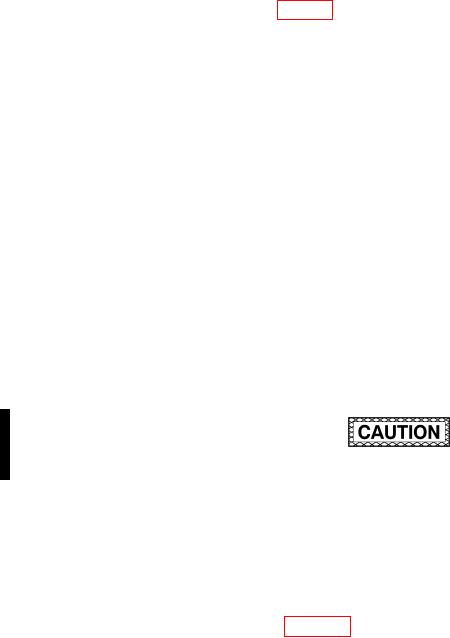
TM 1-1510-262-10
to keep the RPM from exceeding approximately 1802 RPM. A solenoid, actuated by the GOVERNOR TEST switch
located on the overhead control panel (Fig. 2-13), is provided for resetting the overspeed governor to approximately
1540 to 1580 RPM for test purposes. If the propeller sticks or moves too slowly during a transient condition causing
the propeller governor to act too slowly to prevent an overspeed condition, the power turbine governor, contained
within the constant speed governor housing, acts as a fuel-topping governor. When the propeller reaches 106% of
selected N2 RPM, the power turbine governor limits the fuel low to the gas generator, reducing N 1 RPM, which in turn
prevents the propeller from exceeding approximately 1802 RPM. During operation in the reverse range, the power
turbine governor is reset to approximately 95% of propeller RPM before the propeller reaches a negative pitch angle.
This ensures that the engine power is limited to maintain a propeller RPM of somewhat less than that of the constant
speed governor setting. The constant speed governor therefore, will always sense an under speed condition and
direct oil pressure to the propeller servo piston to permit propeller operation in beta and reverse ranges.
2-47. LOW PITCH STOP.
Low pitch propeller position is determined by a mechanically monitored, hydraulic low pitch stop. Four spring-loaded
sliding rods to the Beta collar mounted behind the propeller connect the propeller servo piston. A carbon brush block
riding in the Beta collar transfers the movement of the collar through the propeller reversing lever to the Beta valve
of the governor. The initial forward motion of the Beta valve from its rigged position blocks off the low of oil to the
propeller. Further motion dumps the oil from the propeller into the reduction gearbox sump. A mechanical stop limits
the forward motion of the Beta valve. Rearward movement of the Beta valve from its rigged position does not affect
normal propeller control. When the propeller is rotating at a speed lower than that selected on the governor, the
governor pump provides oil pressure to the servo piston decreasing pitch of the propeller blades until the feedback
of motion from the Beta collar pulls the Beta valve into a position blocking the supply of oil to the propeller, thus
preventing further pitch changes.
2-48. GROUND FINE.
Propeller speeds below 1000 rpm are not authorized, unless the propeller is feathered.
Lifting the POWER levers and moving them aft, past the light idle stop, will place the POWER levers into the ground
ine position. Approximately half way back to the ground ine gate, a mechanical linkage at the propeller governor
will begin to bleed Py air from the fuel control unit, provided the PROP levers are positioned to the FEATHER detent.
This results in a decrease in both engine N 1 torque and propeller rpm. With the power levers at the ground ine gate,
engine N 1 should be within the range of 62% to 67%, and propeller rpm should not be less than 1000 rpm.
2-49. PROPELLER AUTOFEATHER TEST SWITCHES.
A switch in the overhead control panel (Fig. 2-13) is provided for operational testing of the propeller systems. The
AUTOFEATHER TEST OFF ARM switch is used to ARM the autofeather function, and allow for an operational
ground test. The TEST position of the switch enables the pilot to check readiness of the autofeather systems, below
89% N 1 .
2-50. PROPELLER SYNCHROPHASER.
a. Description. The propeller synchrophaser matches left and right propeller RPM as well as propeller phase
relationship. This phase relationship is designed to decrease cabin noise, and is not adjustable in light. A push-
button selector, placarded PROP SYNC ON installed adjacent to the synchroscope in the pilot s instrument panel,
turns the system on/off.
Signal pulses occurring, once per revolution of the propeller are obtained from magnetic pickups (located in the front
of the engine on the deice brush mounting bracket) when the target (mounted on the aft side of the spinner bulkhead)
passes the magnetic pickup. The signal pulses are sent to a control box installed forward of the pedestal. The control
box receives these signal pulses and compares between them for pulse rate and relative position. Differences in
pulse rate and/or propeller position causes the control box to vary the voltage in the primary governor coil, which in
turn, increases propeller speed until the correct speed and phasing is obtained.
A governor coil increases the speed set by the propeller control lever, but never decreases the speed set by the
control lever. The maximum synchrophaser range is approximately 20 RPM. This limited range prevents either
propeller from losing more than a limited RPM if the other propeller is feathered with the synchrophaser ON. There
is no master or slave engine in this type system. There is a limited range for synchronizing, called the "holding range"
which serves to allow one propeller to be feathered without the other decreasing any appreciable RPM. There is a
Change 1
2-52

